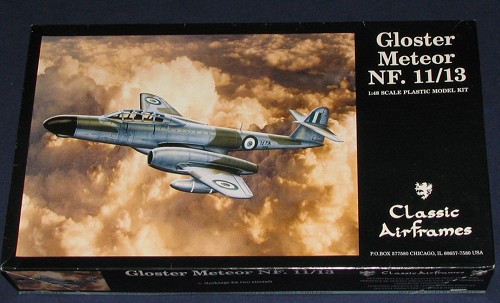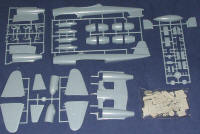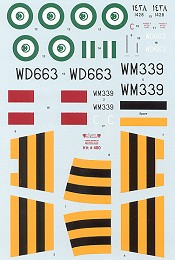
| KIT: | Classic Airframes 1/48 Gloster Meteor NF.11/13 |
| KIT #: | 480 |
| PRICE: | $55.00 MSRP |
| DECALS: | options |
| REVIEWER: | Scott Van Aken |
| NOTES: | Multimedia kit with resin parts |

| HISTORY |
"In January 1947, the Air Ministry issued the specification F.44/46 for a two-seat, twin-jet-engine, night / all-weather fighter to replace the de Havilland Mosquito. A number of companies responded to the request, but none of their proposals met the requirement.
Since there was still a need for a night fighter, Gloster suggested stretching the T.7 by 1.5 meters (five feet) to accommodate airborne-intercept (AI) radar in the nose. This was intended as an interim solution until the Gloster Javelin, then in development, was ready for service.
The proposal was accepted under the specification "F.24/48", but Gloster, having brought up the suggestion, was forced to admit that the company didn't have the resources to produce the machine. However, Armstrong-Whitworth, another member of the Hawker-Siddeley industrial group along with Gloster, had second-sourced the Meteor, and in 1949 Armstrong-Whitworth was given ownership of the project.
The first Meteor "NF.11" (Night Fighter Mark 11) or "G/47" prototype, a modified T.7, began flight tests in October 1949. The first true NF.11 prototype flew on 31 May 1950. The NF.11 retained the Derwent 8 engines of the F.8, but the four cannon were transferred from the nose to the wings, the wings were lengthened back to the original Meteor I span, and the longer nose accommodated AI.10 (US SCR-720) radar and a pressurized tandem cockpit. The cockpit featured a T.7 greenhouse canopy and a radar operator / navigator in the back seat.
The first production NF.11, with a proper Meteor F.8 tail, flew on 13 November 1950, and 307 production NF.11s were built. The Danes bought 11, the Belgians obtained 24 ex-RAF aircraft, somewhat surprisingly the French bought 41 used RAF NF.11s, and a single example was sent to Australia.
* The NF.11 was followed by the "NF.13" and "NF.12", in that order, with the reversal of the numeric sequence apparently due to the fact that the NF.13 revision was started later than the NF.12 but, being a more modest upgrade, was completed sooner. All the Meteor night fighter variants retained the "G.47" company designation.
In fact, the NF.13 was largely identical to the NF.11, except that it had a radio compass, cockpit cooling ducts, and other changes for tropical operation, and larger intakes to improve air mass flow to the engines, resulting in 45 kilograms (100 pounds) more thrust. The first NF.13 flew on 23 December 1952, and 40 were built.
The NF.12 featured Derwent 9 engines with 16.9 kN (1,725 kgp / 3,800 lbf) thrust each, and the nose lengthened by 43 centimeters (17 inches) to accommodate improved American Westinghouse AN/APS-21 radar. The top half of the vertical tailplane was enlarged to compensate for the longer nose, giving the tailplane a slightly crooked appearance.
The first NF.12 flew on 21 April 1953, with 100 being built. France obtained two for test purposes, and six each ex-RAF aircraft were provided to Egypt, Syria, and Israel.
* The "NF.14" was generally similar to the NF.12, but featured a "blown" clear-vision canopy to provide a much-improved view compared to the old framed canopy; improved US AN/APQ-43 radar and an even longer nose; yaw dampers to control "snaking"; and other lesser changes. 100 NF.14s were manufactured, and were the last Meteors built, with the very last of the breed delivered on 26 May 1955.
The Meteor night fighters remained in front-line RAF service until 1961. The total number of Meteor night-fighters built by Armstrong-Whitworth was 547. "
| THE KIT |
 Doing a preview once the kit has already been featured in a build article isn't the easiest thing to do, but I think it is important that one get the opportunity to see just what comes in the box. It provides some perspective on the amount of effort that the builder had to put into the finished product.
Doing a preview once the kit has already been featured in a build article isn't the easiest thing to do, but I think it is important that one get the opportunity to see just what comes in the box. It provides some perspective on the amount of effort that the builder had to put into the finished product.
Classic Airframes has always strived to provide the builder with a kit that can be built properly right out of the box without the need to resort to aftermarket bits to give the additional detail that some modelers like to add to their work. The plastic is a bit thicker than the norm, but not at all unusual for a short run kit. Detail is nicely engraved and this kit provides a rather hefty bag of resin for a lot of the detail parts.
For the record, the resin consists of ALL the bits needed for the cockpits as well as some nese gear bits and the wheels. There are also some scoops and other smaller bits in resin, but the majority of the parts go in the cockpits. You'll also need 60 grams of weight (that is 2 ounces) as the Meteor is a major tail sitter. Fortunately, you have that nice, big rad ome to properly stuff with weight.
ome to properly stuff with weight.
There are options of a sort. One is the choice of larger or smaller intakes. Actually, the big intakes were a requirement for the NF.13, but it wasn't unusual for the NF.11 to have them. There is a centerline belly tank and wing tanks. Since these early turbojets were thirsty suckers, it was not uncommon for all three to be carried. There are also a few antennas that will depend on the references you use as to whether they were carried or not.
Instructions are very good with well drawn construction sequences. They include a number of additional diagrams to be sure you get things properly aligned. As with all kits of this type, lots of dry fitting is recommended, as trouble early will only make things worse a bit later in the build.
Markings are provided for three aircraft. One is the box art NF.13 of the Egyptian Air Force in 1955. Then there is a 5 Sq RAF NF.11, and a 39 Sq NF.13, properly adorned with Suez Stripes. The kit decals are superbly printed by Microscale so are of the highest quality available. Not shown is an additional sheet with stencils and RAF roundels. As you note in the intro, several other countries flew these versions, and I do believe that Xtradecal provides a sheet with several options on it, though I've not seen it.
| CONCLUSIONS |
This will be the final kit in Classic Airframe's Meteor family, so there will be no NF.12/14. Still, it is a very nice kit of an important aircraft with the RAF. It isn't a snap to build as the various articles in MM will attest, but you are given all the parts needed and you only need to apply skill to have a super representation of what was probably the RAF's last purpose-built night fighter.
August 2005
| REFERENCES |
http://www.vectorsite.net and other internet browsings
Review kit courtesy of  Thanks for your support.
Thanks for your support.
If you would like your product reviewed fairly and quickly by asite that has around 300,000 visitors a month, please contactme or see other details in the